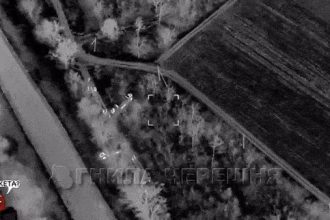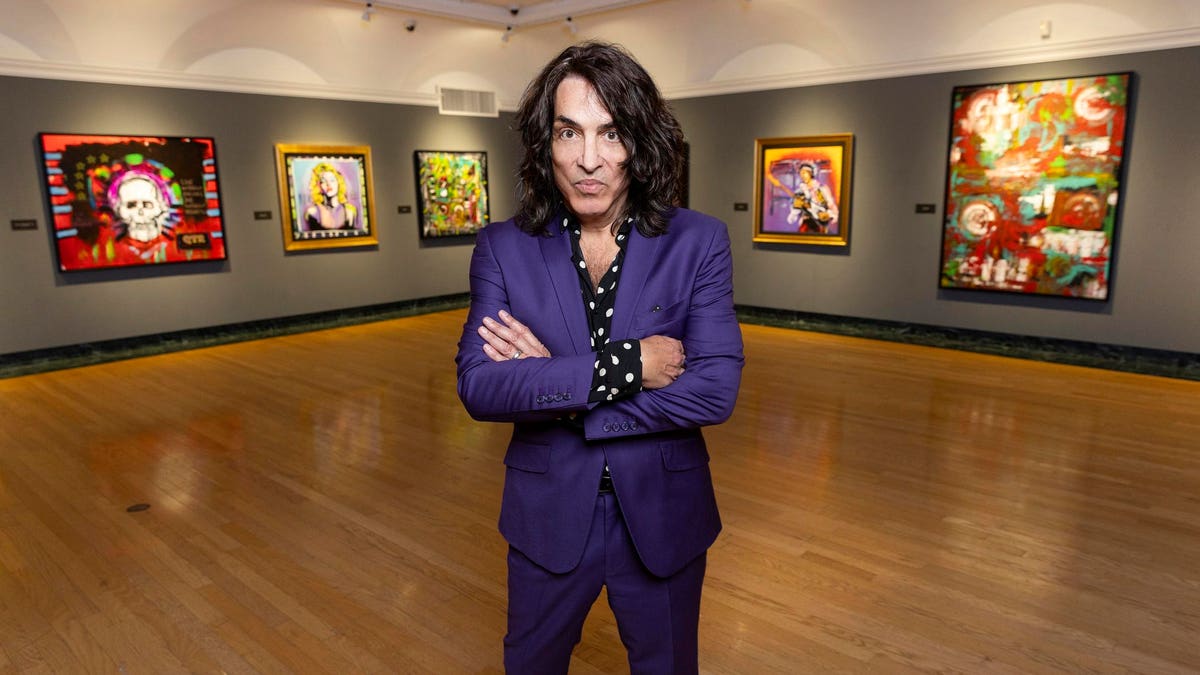50 years after their 1973 formation in New York, the final Kiss tour is winding down, with a December 2 stop at Madison Square Garden standing as the final scheduled date of the group’s current ‘End of the Road’ world tour, leaving each member to ponder what’s next.
For singer and guitarist Paul Stanley, painting has grown to become more than just a hobby over the course of the last 20 years. While the work initially offered him a new creative outlet in which to purge emotionally during a difficult stretch, today it stands as a well-respected, frequently exhibited collection.
Defined by his use of bold colors and utilization of black canvases instead of the traditional white, Stanley’s work takes on an optimistic tone, a collection that runs the gamut between self-portraits and more abstract pieces, continually evolving.
“Paul is probably one of the most creative people I’ve ever met,” said Christian O’Mahony, CEO at Wentworth Gallery, one of the nation’s top purveyors of fine art. “He started off working very structured in terms of a vase of flowers or a portrait of Marilyn Monroe. But, from there, he really wanted to create pieces and capture the moment – everything emotional at that time. So, he’s grown unbelievably as an artist,” he said. “Every year that I see new works from him, they just keep getting more sophisticated – more emotional and better. He’s also obviously extremely famous for his other creativities. But, as a visual artist, he’s entering new levels each year.”
Following appearances earlier this year at several Wentworth galleries, Stanley’s work is currently on display at the prestigious Butler Institute of American Art, where an exhibition titled “The Other Side” is set to run through October 22.
The Butler Institute stands as the first museum to focus solely on the work of American artists, operating pro bono in Youngstown, Ohio for over 100 years.
At the Butler, Stanley’s pieces now adorn the walls alongside works by legendary artists like Georgia O’Keeffe, Edward Hopper, Winslow Homer and Robert Vonnoh.
“They were so generous in wanting to do it,” said Stanley of the Butler Institute during an August reception in Youngstown unveiling “The Other Side” exhibition. “You only have to walk around and see the Wyeths and the Sargents and all of these amazing pieces that are here. And if you’re invited to a party with those people, then you show up!” said the Rock and Roll Hall of Famer with a smile. “Certainly, seeing the Rockwell that’s here, it’s different than what you imagine when you think of the magazines that he was so well-known for doing the covers of,” said Stanley following a tour of the museum, referencing Norman Rockwell’s “Lincoln the Railsplitter,” a painting on display at the Butler since its 2007 acquisition. “And then I can’t see an Andy Warhol without knowing that Andy wanted to do a portrait of me. And I kept saying, ‘Sure. One of these days…’ So, I think that you should seize the moment,” he reflected. “Otherwise, you have to contend with hitting your head against the wall. Because when somebody like Andy Warhol wants to do your portrait, you run in his direction!”
“The Other Side” collection features works like “Quality Time Remaining,” an introspective piece which captures the desire of Stanley, 71, to make the most of the time he’s got left.
Stanley, who took on the role of Phantom in a 1999 Toronto production of The Phantom of the Opera, hopes that his work will lead to a larger embrace of art and theater, worlds often generalized as being out of reach for the average American.
“It’s very important to me to break down those barriers that are really based in elitism and snobbery,” he explained. “Because the people who miss out are the general public – because they are intimidated into not participating and experiencing art or the arts because they think that they have to be educated in one of those fields to enjoy it – that purely enjoying something is not good enough. And that’s nonsense,” Stanley said. “If you see art or if you hear music, and it elicits an emotional response, there’s no reason for you to have to analyze that. We should be finding a way to make the experience of going to a gallery or a theater inviting as opposed to forbidding.”
Admission at the Butler Institute remains free of charge, with the distinguished museum sharing Stanley’s vision for a greater general embrace of the arts.
As Kiss stares down its final run of live dates, Stanley nevertheless looks forward to what’s next.
“Seeing this come to fruition is something I never could’ve imagined when I started painting,” he said in Youngstown, taking stock of the new exhibition. “I started painting totally as a solitary and personal endeavor. And it turned into so much more. So, to even fathom the idea of having enough work to be displayed is mind boggling. And then to have people who connect to it and want it in their homes is something that, again, I never could have fathomed,” he said. “I’m just so grateful for people who understand art without necessarily having to have a background in art. Those are free thinkers. And I’m touched.”
Read the full article here





